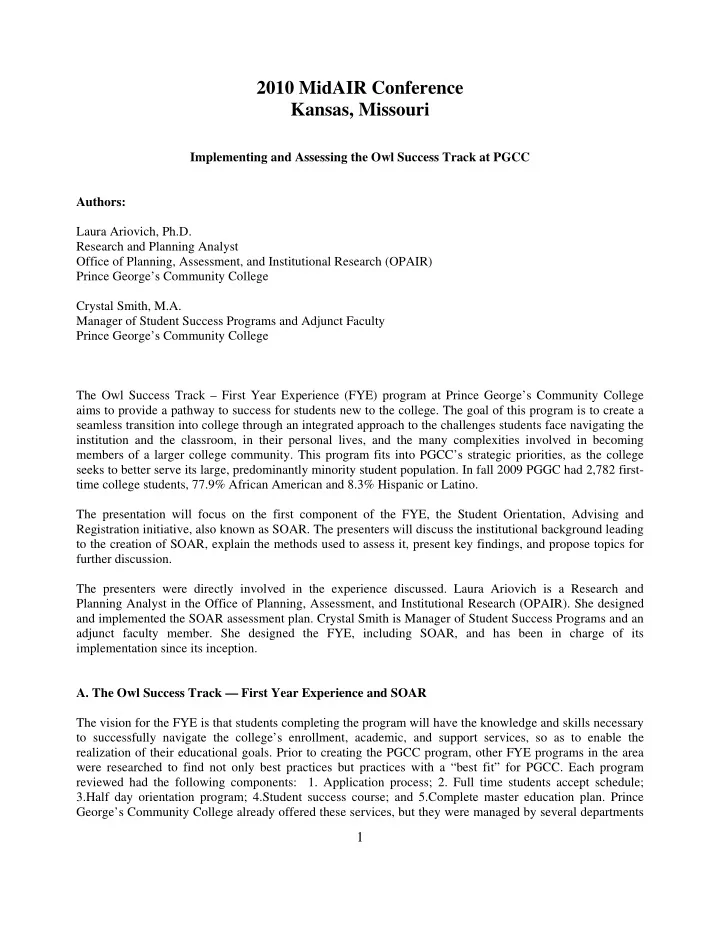

2010 MidAIR Conference Kansas, Missouri Implementing and Assessing the Owl Success Track at PGCC Authors: Laura Ariovich, Ph.D. Research and Planning Analyst Office of Planning, Assessment, and Institutional Research (OPAIR) Prince George’s Community College Crystal Smith, M.A. Manager of Student Success Programs and Adjunct Faculty Prince George’s Community College The Owl Success Track – First Year Experience (FYE) program at Prince George’s Community College aims to provide a pathway to success for students new to the college. The goal of this program is to create a seamless transition into college through an integrated approach to the challenges students face navigating the institution and the classroom, in their personal lives, and the many complexities involved in becoming members of a larger college community. This program fits into PGCC’s strategic priorities, as the college seeks to better serve its large, predominantly minority student population. In fall 2009 PGGC had 2,782 first- time college students, 77.9% African American and 8.3% Hispanic or Latino. The presentation will focus on the first component of the FYE, the Student Orientation, Advising and Registration initiative, also known as SOAR. The presenters will discuss the institutional background leading to the creation of SOAR, explain the methods used to assess it, present key findings, and propose topics for further discussion. The presenters were directly involved in the experience discussed. Laura Ariovich is a Research and Planning Analyst in the Office of Planning, Assessment, and Institutional Research (OPAIR). She designed and implemented the SOAR assessment plan. Crystal Smith is Manager of Student Success Programs and an adjunct faculty member. She designed the FYE, including SOAR, and has been in charge of its implementation since its inception. A. The Owl Success Track — First Year Experience and SOAR The vision for the FYE is that students completing the program will have the knowledge and skills necessary to successfully navigate the college’s enrollment, academic, and support services, so as to enable the realization of their educational goals. Prior to creating the PGCC program, other FYE programs in the area were researched to find not only best practices but practices with a “best fit” for PGCC. Each program reviewed had the following components: 1. Application process; 2. Full time students accept schedule; 3.Half day orientation program; 4.Student success course; and 5.Complete master education plan. Prince George’s Community College already offered these services, but they were managed by several departments 1
and offices. Through the FYE program, the college was able to streamline the advising and registration experience for new students. The first task was to create a definition of a “first year student” as it relates to PGCC. A first year student was defined as “a student who has attempted less than 18 credit hours or the equivalent, at Prince George’s Community College.” Once the definition was created, a program that would specifically benefit this population was designed. The initial component of this program was the Student, Orientation, Advising, and Registration initiative (SOAR). The goals of this orientation are divided into three categories: • Institutional Understanding , including the goal of assisting students in understanding the purpose of higher education • Academic Understanding , including the goal of providing information concerning academic policies, procedures and requirements • Student and Parent Transition , including the goal of creating an atmosphere that minimizes anxiety, promotes positive attitudes, and stimulates an excitement for learning The second task was to ensure that the orientation program would benefit students attending all PGCC locations. The main campus, Largo, has the staff and resources to offer full-day, face-to-face orientation sessions to new students. The full-day sessions contained several workshops facilitated by staff members from various departments. Running these workshops required a detailed assignment schedule requesting staff members to volunteer for presentations. However, because of staff size and limited resources, the College’s off-campus centers are not equipped to handle full day, face-to-face orientation sessions offered several days during the week. To remedy this issue, an on-line version of the SOAR orientation containing the information students received face-to-face was created. The off-campus centers are able to utilize the on-line version of SOAR for most of the orientation and then complete the advising and registration process face-to-face. This hybrid format allows the off-campus locations to offer a comprehensive orientation program without requiring as many staff members. In addition, the work schedules of Largo campus staff were adjusted to assist the other locations as needed. The on-line version of SOAR is also available for all students who are not able to attend the face-to-face or the hybrid sessions. These students go through the on-line orientation on campus or at home and then meet with an advisor for registration. Once the program was put into place, the next step was to determine the assessment plan. B. The SOAR Assessment Plan The assessment of SOAR was conducted by PGCC’s Office of Planning, Assessment, and Institutional Research (OPAIR). Providing an accurate assessment required that three issues be addressed. First, how could feedback be obtained from students participating in SOAR? Second, how could the assessment be useful for the SOAR leadership team as a means to allow for continuous improvement? And third, how could data be captured dynamically, i.e. as the program was occurring, rather than after the fact via survey administration? 2
Recommend
More recommend